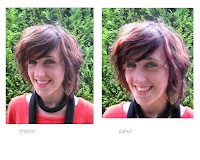I felt before beginning the task of producing a front cover, contents page and main feature of a magazine I should first research into the subject. I first gathered a selection of different magazine front covers and analysed their content.
The first magazine I looked at was Rolling Stone. The front covers of this magazine are typically highly stylised with a well considered colour scheme and balance of graphology. The masthead is obscured by the singer which suggests her importance and status over the magazine itself, as well as providing an easy recognition for the potential reader.
The photograph is revealing, which supports Laura Mulvey's idea of the male gaze by showcasing the female sexuality. Both her hair and make up are extreme but clothing is minimal, which provides balance to the photograph. The graphology itself is suggestive of a female presence – the pink background, bubbles, and white writing presenting the stereotypical ‘girlishness.’
The cover puffs are arranged a in long row at the side of picture, with a smaller font showing their lesser importance compared to the other main articles.
The font used is white with a black outline, making the text stand out from the pink background. The capitalised font used for the main articles provide a title for the main articles and display their importance over the smaller article titles.














